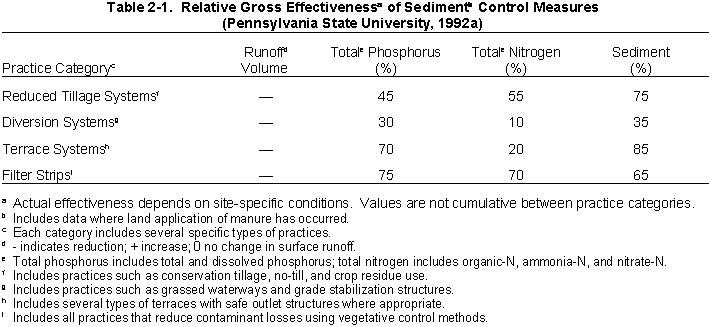
US EPA. 1993. Guidance Specifying Management Measures for Sources of Nonpoint Pollution in Coastal Waters. EPA-840-B-93-OOLC, US EPA, Office of Water, Washington, D.C.
| To the previous article | To the next article |
Soil Erosion results in the movement of sediment and associated pollutants by runoff into a body of water (EPA, 1993). This is a serious problem throughout the world and in the United States, even after years of trying to control it. The use of more row crops and larger farms that are being tilled by one operator have made it difficult to ease the process of erosion. Also, federal programs have historically supported high levels of production that result in farmers avoiding erosion control practices.
Soil erosion and the subsequent transport of sediment from the land surface to a receiving body of water is a function of a complex system of processes. The most important part of this process in terms of water quality are the processes acting on the surface of the land and controlling sediment transport to the edge of the field. Soil erosion and sediment transport within a field are a function of raindrop impact which causes the soil particles to detach and the energy of overland flow which also contributes to detachment and carries suspended sediment downslope (Logan, T.J., pp. 591). These processes depend on the nature of the soil surface at the time of rainfall and on the extent to which the surface is covered by plant residues or growing plants. A large amount of soil surface cover leads to lower levels of soil erosion.
Combinations of some of the following practices can help to improve erosion and sediment control (EPA, 1993):
1. Conservation Cover: establish and maintain perennial vegetative cover to protect soil and water resources from land retired from agricultural production.
2. Conservation Cropping Sequence: an adapted sequence of crops designed to provide adequate organic residue, which results in a reduction of the transport of sediment and associated pollutants to surface waters.
3. Conservation Tillage: any tillage or planting system that maintains at least 30% of the soil surface covered by residue after planting to reduce soil erosion by water. This practice also reduces detachment and sediment transport by providing soil coverage during the critical times in the cropping cycle.
4. Contour Farming: sloping land should be farmed so that preparing land, planting, and cultivation are done on a contour. By establishing these terraces sedimentation production and erosion will be reduced.
5. Critical Planting Area: planting vegetation, such as, trees, shrubs, vines, grasses, or legumes, on highly erodible or critically eroding areas. This practice can help reduce soil erosion and sediment delivery to surface waters.
6. Crop Residue Use: using plant residues to protect cultivated fields during critical erosion periods. This residue will intercept raindrops and increase microbial growth near the surface, which can utilize excess nitrate.
7. Delayed Seedbed Preparation: wait until three weeks before planting to remove crop residues and other vegetation. This minimizes the time under which critical erosion can occur by shortening the bare seedbed time.
8. Field Border: a strip of vegetation established at the edge of a field to reduce erosion.
9. Filter Strip: a strip or area of vegetation that removes sediment, organic matter, and other pollutants from runoff and wastewater.
10. Contour Strip-Cropping: growing crops in a systematic arrangement of strips or bands across the general slope to reduce water erosion. This practice may also increase the amount of water that reaches the root zone.
11. Terrace: an earthen embankment, a channel, or a combination of both constructed across a slope. A terrace will reduce the slope of the land, which is critical to the rate of erosion.

 |